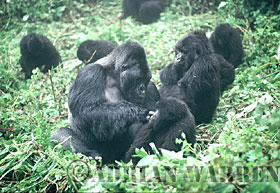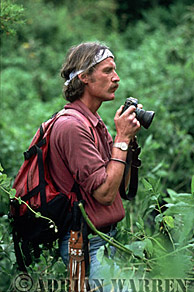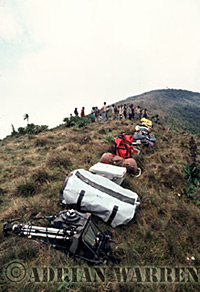|
MOUNTAIN
GORILLA
THE
MAKING OF THE IMAX FILM
by
Adrian Warren
(Director)

Mountain Gorilla (Gorilla
g. beringei), Virunga Volcanoes, Rwanda
As we approached
the gorillas, Craig would go on ahead to assess their mood and situation.
Meanwhile, Neil, Kim, Chris and I would start to assemble the equipment.
Then, under the watchful gaze of our gorilla friends we would slowly move
the equipment in piece by piece - first the tripod, then the tripod head,
battery, cables, lenses, and finally the monster camera itself which took
two people to carry. Every move we made had to be calm and gentle, so
the process was a slow one. Often by the time we were ready the gorillas
decided it was time to move on; and so, after hours of climbing up the
mountain with the equipment, and finding the gorillas we would have to
disassemble it again and follow them. This process could repeat itself
for days on end with no film passing through the camera. But then suddenly
it would all happen and we would come down the mountain at the end of
the day exhausted but triumphant. Wielding the IMAX camera around the
Virunga Volcanoes was a daunting task. Normally when you go on the road
with an IMAX crew and sixty or so cases of equipment you work out of a
10 ton truck and a couple of 4-wheel drives thrown in. In the Virungas
we were on foot, and even with the equipment reduced to a minimum we employed
at least sixteen porters on a daily basis to help us. The camera had to
be supported on a tripod for filming - there was no way it could be hand
held like a 16mm camera can. So once it is in place it is not very versatile
or manoeuvrable.
 Craig Sholley
Craig Sholley |
 Team on location
Team on location |
Sometimes we
would have the camera ready for one shot and a gorilla would sneak up
behind us and catch us unawares. We also had to keep a careful eye on
any objects we placed on the ground - the gorillas are intelligent, observant
and curious, and more than once we almost lost a lens or a plastic bag
when a young gorilla made a cunning approach and took us by surprise.
After many
weeks of work with the same gorillas, they seemed to accept our presence
very readily. I often wondered how we seemed to them - did they wonder
where we disappeared to at night? After working with the tripod for many
weeks we tried using a rail device to give the camera some movement on
group shots. The gorillas were very curious about this new piece of equipment
and we had to be careful about its use. It meant having an immense amount
of hardware close to the gorillas, and such were the complications in
setting it up that one shot was all we could expect to achieve in a day,
if we were lucky. For that reason we worked hard on filming behaviour,
pure and simple, from the beginning, a decision which I was very happy
to have made when hostilities brought our work to an untimely end.
|
